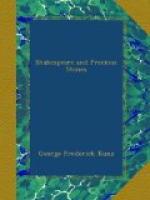The poem has sometimes been attributed to Edmund Falconer (1814-1879), an actor and dramatist, born in Dublin, and whose real name was Edmund O’Rourke. However, his poem entitled “Anne Hathaway, A Traditionary Ballad sung to a Day Dreamer by the Mummers of Shottery Brook",[15] falls far below the lines we have quoted in poetic quality, as may be seen from the opening stanza (the best), which runs as follows:
No beard on thy
chin, but a fire in thine eye,
With lustiest
Manhood’s in passion to vie,
A stripling in
form, with a tongue that can make
The oldest folks
listen, maids sweethearts forsake,
Hie over the fields
at the first blush of May,
And give thy boy’s
heart unto Anne Hathaway.
[Footnote 15: Edmund Falconer, “Memories, the Bequest of my Boyhood”, London, 1863, pp. 14-22.]
In none of the allusions to precious stones made by Shakespeare is there any indication that he had in mind any of the Biblical passages treating of gems. The most notable of these are the enumeration of the twelve stones in Aaron’s breast-plate (Exodus xxviii, 17-20; xxxix, 10-13), the list of the foundation stones and gates of the New Jerusalem given by John in Revelation (xxi, 19-21), and the description of the Tyrian king’s “covering” in Ezekiel (xxviii, 130). Had the poet given any particular attention to these texts we could scarcely fail to note the fact. Other Bible mentions, such as those elsewhere made by Ezekiel (xxvii, 16, 22), regarding the trade of Tyre, the agates (and coral) from Syria, and the precious stones brought by the Arabian or Syrian merchants of Sheba and Raamah, are too much generalized to invite any special notice. The same may be said of most of the remaining brief allusions. We might rather expect that where the color or brilliancy of a precious stone is used as a simile this might strike a poet’s fancy and perhaps find direct expression in his own words. The light of the New Jerusalem is likened to “a jasper stone, clear as crystal” (Rev. xxi, 11), and in Exodus (xxiv, 10) the sapphire stone is said to be “as it were the body of heaven in its clearness”. However, that Shakespeare wrote of “the heaven-hued sapphire” ("Lover’s Complaint”, l. 215) has no necessary connection with this, as the celestial hue of the beautiful sapphire is spoken of time and again by many of the older writers.
FIVE OF THE SIX AUTHENTIC SHAKESPEARE SIGNATURES
[Illustration: Signature on the purchase deed of Shakespeare’s house in Blackfriars dated March 10, 1613. In the Guildhall, London]
[Illustration: Signatures on the three pages of Shakespeare’s will executed March 25, 1616. Original in Somerset House, London]
[Illustration: Signature attached to the deed mortgaging the house in Blackfriars, dated March 11, 1613. In the British Museum]




